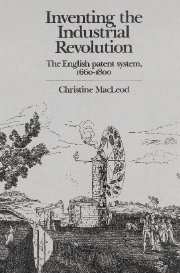Book contents
- Frontmatter
- Contents
- List of tables and figure
- Acknowledgements
- List of abbreviations
- Notes on style
- Introduction
- 1 Patents 1550–1660: law, policy and controversy
- 2 The later-Stuart patent grant – an instrument of policy?
- 3 The development of the patent system, 1660–1800
- 4 The judiciary and the enforcement of patent rights
- 5 The decision to patent
- 6 Invention outside the patent system
- 7 Patents in a capitalist economy
- 8 The long-term rise in patents
- 9 The goals of invention
- 10 Patents: criticisms and alternatives
- 11 A new concept of invention
- Notes
- Bibliography
- Index
6 - Invention outside the patent system
Published online by Cambridge University Press: 28 October 2009
- Frontmatter
- Contents
- List of tables and figure
- Acknowledgements
- List of abbreviations
- Notes on style
- Introduction
- 1 Patents 1550–1660: law, policy and controversy
- 2 The later-Stuart patent grant – an instrument of policy?
- 3 The development of the patent system, 1660–1800
- 4 The judiciary and the enforcement of patent rights
- 5 The decision to patent
- 6 Invention outside the patent system
- 7 Patents in a capitalist economy
- 8 The long-term rise in patents
- 9 The goals of invention
- 10 Patents: criticisms and alternatives
- 11 A new concept of invention
- Notes
- Bibliography
- Index
Summary
There is nothing novel in claiming that there was inventive activity outside the purview of the patent system. I shall argue here, however, that omission was not random: it was far more likely to occur in some industries than in others, and in certain sectors within an industry. There are major disparities between the economic importance of most industries and their level of representation in the patent records. Looking at the period from 1750 to 1800, one finds that only textiles (including hosiery and lace) and metalworking (including plating and gunmaking) – each with approximately 14 per cent of total patents – defy this pattern and indicate their prominent place in the economy. Agriculture, still in 1800 the employer of over a third of the workforce, took under 4 per cent of patents. The three largest industrial employers after textiles (the leather, building, and food and drink trades) accounted for 4 per cent each; the heavy industries (mining and metallurgy) for less than 4 per cent together. Nine per cent of patents were in transport, but two-thirds of them related to road transport (overwhelmingly, carriages and coaches for passengers), only a third to the shipping and canal traffic whose carriage of freight was of greater industrial importance. Enginemaking, which was crucial to industrialization, accounted for 11 per cent; this was disproportionately large, however, in regard to its direct economic importance as either an employer of labour or a generator of wealth.
- Type
- Chapter
- Information
- Inventing the Industrial RevolutionThe English Patent System, 1660–1800, pp. 97 - 114Publisher: Cambridge University PressPrint publication year: 1988



